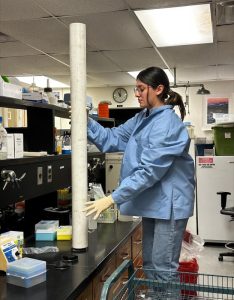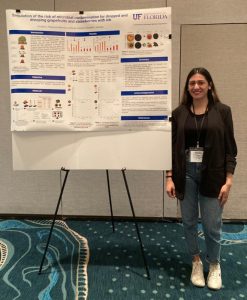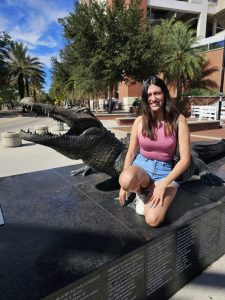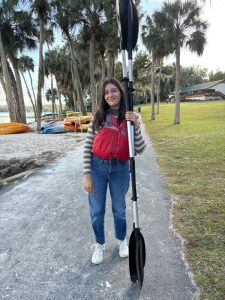 We are pleased to welcome Claudia Pegueros to our FSHN Research Journeys series, which follows graduate students’ research in the Food Science and Human Nutrition program at The University of Florida. Claudia is a food science master’s degree student committed to researching how to make our produce safer. In her research project, she studies E. coli contamination of strawberries and grapefruit, aiming to update food safety standards under certain growing conditions.
We are pleased to welcome Claudia Pegueros to our FSHN Research Journeys series, which follows graduate students’ research in the Food Science and Human Nutrition program at The University of Florida. Claudia is a food science master’s degree student committed to researching how to make our produce safer. In her research project, she studies E. coli contamination of strawberries and grapefruit, aiming to update food safety standards under certain growing conditions.
Claudia: Food is vital for any living being, and we must focus on bringing high-quality and safe food to each home. My goal is to contribute to science by researching and developing strategies that allow us to prevent the biological contamination of food.

Foodborne Illnesses: A Growing Public Health Concern
Foodborne illnesses are a critical issue for public health. Worldwide, foodborne pathogens cause an estimated 600 million illnesses and 420,000 deaths annually.1 In the United States alone, these pathogens cause an estimated 48 million cases, 128,000 hospitalizations, and 3,000 deaths annually.2 Pathogens on produce like fruits and vegetables cause 46% of foodborne illnesses.3 Unfortunately, foodborne illnesses due to produce consumption have increased over time, creating a critical public health issue.4,5
Many produce items like lettuce and cantaloupe are eaten raw, forgoing the cooking heat required to eliminate some harmful microorganisms. Therefore, fresh produce is more likely to cause foodborne illnesses if contaminated with pathogens.5 The main pathogenic organisms connected with produce outbreaks are bacteria (Escherichia coli, Listeria monocytogenes, and Salmonella), viruses (hepatitis A virus and norovirus), and parasites (Cryptosporidium parvum, Cyclospora cayetanensis).4,5,6

Dropped vs. Drooped Produce: Potential Sources of Contamination
To prevent produce pathogen contamination, the Food and Drug Administration (FDA) regulates agricultural practices in the US through the Food Safety Modernization Act (FSMA).7 FSMA includes the Produce Safety Rule (PSR)8 which established science-based minimum standards for the safe growing, harvesting, packing, and holding of covered produce grown for human consumption.
One part of the PSR states that growers must not distribute dropped-covered produce (produce that drops to the ground before harvest). Dropped produce are at risk of contamination due to contact with the ground, and the impact can damage the outside layer, making them more susceptible to the internalization of pathogens.9,10
However, this PSR section does not mention drooped produce (produce in contact with the ground but still attached to the plant) which may also be prone to pathogen contamination or internalization due to contact with the ground. Both dropped and drooped produce may represent a food safety risk, and we need to better understand the risks associated with harvesting dropped or drooping produce under various conditions.

Exploring the Landscape: A Journey into the World of Food Safety
Since I was a kid, I have dreamed of becoming a scientist. Another activity I have enjoyed since I was young was spending time in the garden. I have always found produce production fascinating. For these reasons, I combined my interests and earned a bachelor’s degree in food chemical engineering. During my undergraduate education, I discovered the food safety and microbiology worlds, and both areas became my research interests. My goal is to contribute to science by researching and developing strategies that allow us to prevent the biological contamination of food.
In mid-2022, the University of Florida accepted me for a six-month internship at the Citrus Research and Education Center, where I researched food safety in fresh fruits and vegetables. In January 2023, I was accepted into the master’s program under Dr. Michelle Danyluk, a produce safety expert. My current research project compares bacterial transfer and internalization in dropped versus drooped strawberries and grapefruit. The objective is to collect scientific evidence and consider some changes in the FSMA related to drooped produce. I am very excited to be part of this project, and I hope my research can one day be significant for the community.

Let’s Get to Work: Conducting the Laboratory Experiments
In my project, I will study strawberries and grapefruit. Florida is the second largest producer of strawberries in the country after California,11 and strawberries are among the most consumed fruits in the US.12 Strawberries have been linked to foodborne illnesses outbreaks, most of them caused by enteric viruses such as Hepatitis A.13 Florida also leads citrus fruit production, 40 percent of which is grapefruit11,14.
The first step of this study is an area assessment. I will simulate the drooping and dropping of strawberries and grapefruits over ink pads from various heights and over different times. I will take pictures of each fruit and measure the percentage of the inked area (PIA, or area with risk of microbial contamination).
The second part of this study is to simulate the drooping and dropping of the fruit under the same conditions, but instead of using ink pads, I will be using inoculated plastic mulch for the strawberries and inoculated sand for the grapefruits. These agricultural matrices (plastic mulch and sand) are the most common ones used to grow these fruits. They will be inoculated with Escherichia coli as a model of bacterial contamination.
After each treatment, the bacterial transfer to the fruit surface and the bacterial internalization into the fruit will be measured using the traditional plate count technique. I will evaluate the influence of time, height, agricultural matrices, and the weight of the fruit on bacterial transfer and internalization. These data will be compared with the results of other universities to create a database that can be used to improve the current regulations.

Charting the Course Ahead: Navigating Future Challenges in Food Safety
Simulating the dropping and drooping in lab settings may limit the usefulness of the collected data. In the field, environmental conditions are not identical. External factors, such as UV exposure, temperature, and rainfall, can affect bacterial transfer and internalization. In addition, competing bacteria or microbes may influence pathogen survival and its capability to transfer to and internalize the produce.
We must recognize the limitations in extrapolating lab results to real-world scenarios. While lab work provides valuable insights, we must be cautious in extending its conclusions to practical applications. We may need to conduct supplementary studies in real fields to fortify our understanding and ensure the effectiveness of food safety measures.
Collecting thorough scientific data to identify risks that may not have been considered is important. The ultimate goal is to use this knowledge to strengthen regulatory measures, significantly reducing foodborne illnesses.
Claudia Pegueros is a food chemistry engineer from Mexico. Her interest in science began at an early age, and while earning her bachelor’s degree, she realized the importance of food safety for public health. At the International Association of Food Protection (IAFP) conference in 2021, she presented her food microbiology research and was one of five finalists for the thesis competition. Now she is pursuing an M.S. in food science at UF under Dr. Michelle Danyluk. Claudia is thrilled to become a food safety specialist and help prevent foodborne illnesses around the world, especially in countries like Mexico.

References
- World Health Organization (WHO). (2022). Food Safety. World Health Organization, 2022. https://www.who.int/news-room/fact-sheets/detail/food-safety. Accessed September 1st ,2023.
- U.S. Food and Drug Administration (FDA). (2022). What You Need to Know about Foodborne Illnesses. https://www.fda.gov/food/consumers/what-you-need-know-about-foodborne-illnesses. Accessed September 1st, 2023.
- Painter, J. A., Hoekstra, R. M., Ayers, T., Tauxe, R. V., Braden, C. R., Angulo, F. J.Griffin, P. M. (2013). Attribution of Foodborne Illnesses, Hospitalizations, and Deaths to Food Commodities by using Outbreak Data, United States, 1998–2008. Emerging Infectious Diseases, 19(3), 407-415. https://doi.org/10.3201/eid1903.111866.
- Jung, Y., Jang, H. and Matthews, K.R. (2014), Vegetable microbial safety. Microbial Biotechnology, 7: 517-527. https://doi.org/10.1111/1751-7915.12178
- Carstens CK, Salazar JK, Darkoh C. Multistate Outbreaks of Foodborne Illness in the United States Associated With Fresh Produce From 2010 to 2017. Front Microbiol. 2019 Nov 22;10:2667. doi: 10.3389/fmicb.2019.02667. PMID: 31824454; PMCID: PMC6883221.
- Wadamori, Y., Gooneratne, R. and Hussain, M.A. (2017), Outbreaks and factors influencing microbiological contamination of fresh produce. J. Sci. Food Agric., 97: 1396-1403. https://doi-org.lp.hscl.ufl.edu/10.1002/jsfa.8125.
- U.S. Food and Drug Administration (FDA). (2011). Food safety modernization act (FSMA) Public law 111-353, U.S. Food and Drug Administration, Washington, DC.
- U.S. Food and Drug Administration.21CFR112. (2015). FSMA final rule on produce safety: standards for the growing, harvesting, packing, and holding of produce for human consumption Fed. Regist, 80, p. 74353
- Riordan, D. C. R., G. M. Sapers, T. R. Hankinson, M. Magee, A. M. Mattrazzo, and B. A. Annous. 2001. A study of U.S. orchards to identify potential sources of Escherichia coli O157:H7. J. Food Prot. 64:1320–1327
- Duffy, S., and D. W. Schaffner. 2002. Monte Carlo simulation of the risk of contamination of apples with Escherichia coli O157:H7. Int. J. Food Microbiol. 78:245–255.
- USDA-NASS. U. S. Department of Agriculture. National Agricultural Statsitcs Service, Washington, DC. (2023). Southern Region News Release Noncitrus Fruits and Nuts.
- Yeargin, T.,Fraser, A., Gibson,K.E. (2021) Characterization of risk management practices among strawberry growers in the southeastern United States and the factors associated with implementation, Food Control, 122. https://doi.org/10.1016/j.foodcont.2020.107758.
- Palumbo,M., Harris, L., Danyluk, M., (2013). Survival of Foodborne Pathogens on Berries. Publication FSHN13-12. 2013 University of Florida, Institute of Food and Agricultural Sciences, Gainesville, FL, USA Available online. https://edis.ifas.ufl. edu/pdffiles/FS/FS23600.pdf. Accessed on September 14, 2023).
- Cruz, J. Ferreira, J.P and Court Christina. (2023). 2020-2021. Economic Contributions of the Florida Citrus Inudstry. https://fred.ifas.ufl.edu/media/fredifasufledu/economic-impact-analysis/reports/FRE_Economic_Contributions_Florida_Citrus_Industry_Report_2020_21_WEB-(2).pdf. Accessed September 10th, 2023.
Looking for more posts exploring graduate research projects in the FSHN Department at the University of Florida?
Dive into the Research Journeys of other graduate students below.
M.S. Food Science
M.S. Nutritional Sciences
Ph.D. Food Science
Ph.D. Nutritional Sciences
 1
1
